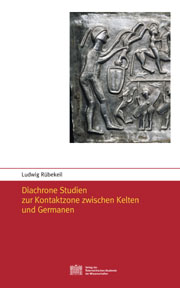Ludwig Rübekeil
Diachrone Studien zur Kontaktzone zwischen Kelten und Germanen
Reihe: Sitzungsberichte der philosophisch-historischen KlasseFrühgeschichtliche Ethnien wie Kelten oder Germanen genießen große Popularität. Darüber gerät bisweilen in Vergessenheit, dass sich viele Phänomene des vor- und frühgeschichtlichen Europa nicht allein ethnisch definieren lassen, sondern aus „interkultureller“ Dynamik zwischen den ethnischen Einheiten erklärt werden müssen. Das vorliegende Buch beschäftigt sich mit Fragestellungen, die aus der Sicht linearer ethnischer Traditionen nur unzureichende Antworten finden. Es geht um die Frage nach Ethnos, Kultur und Geschichte der früher als Germanen angesehenen Chatti und Hessen. Der Ursprung der Götter Wodan und Loki wird thematisiert und die Rolle von Moorleichen und Menschenopfern hinterfragt. Zur Sprache kommen schließlich auch Namengeschichte, historische Typologie und Ethnogenese der Chattuarii, Baioarii, Ripuarii und ähnlicher Gruppen. Es wird gezeigt, dass sich die behandelten Phänomene zum guten Teil aus den strukturellen Gegebenheiten ethnischer Interferenzzonen erklären, wobei die Kontaktzone zwischen Kelten und Germanen im Zentrum steht.
…
The study of prehistoric cultures such as the Celtic or Germanic peoples is currently in vogue. As a result, however, it tends to be forgotten that many phenomena cannot be accounted for in purely ethnic terms. Rather than define phenomena dating back to the early history of Europe solely in terms of ethnos, they have to be explained within the context of ”intercultural“ dynamicism between the ethnic groups.
The present book deals with questions to which linear ethnic traditions find only insufficient answers. It sheds light on the ethnos, culture, and history of the Chatti, a tribe formerly considered to be Germanic. In addition, it discusses the onomastic relation between Chatti and Hessen, a topic which has led to some controversy. It also analyses the origin of the gods Wodan and Loki and the function of human sacrifices and bog people.
Finally, the name history, historical typology and ethnogenesis of the Chattuarii, Baioarii, Ripuarii and similar groups will be brought up. Focusing on the contact between the Celts and the ancient Germanic people, the book aims to show that the phenomena mentioned above can be sufficiently explained if the structural conditions of zones of ethnic interference are taken into account.
